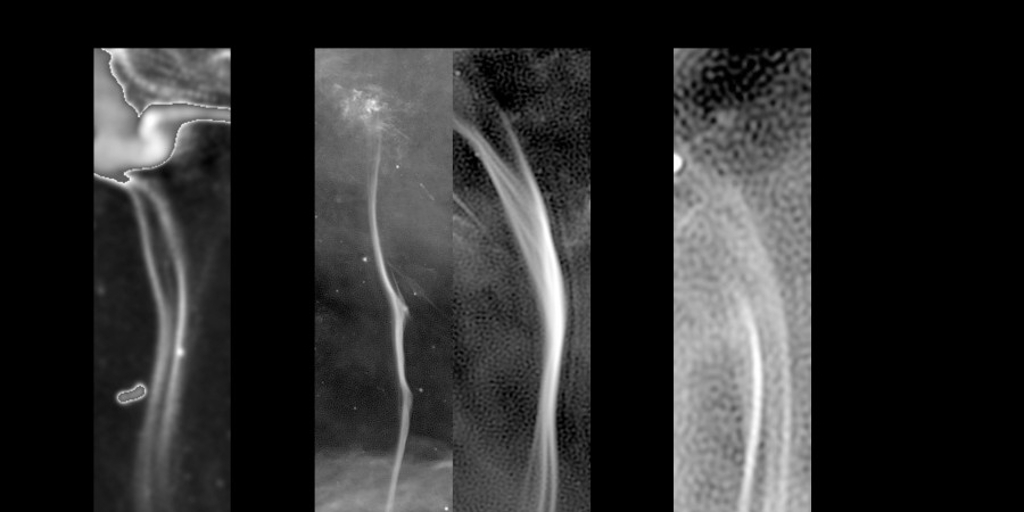In January of the same year, a team of astronomers from Northwestern University in Illinois announced a strange discovery: more than a thousand Mysterious threadsIt is 150 light-years across, “hanging” from the center of our galaxy. After many years of work, researchers led by Farhad Zadeh were able to take pictures of the interesting phenomenon, in which the strings appeared in pairs, or in groups, one next to the other like the strings of a harp. Something definitely baffling and hard to explain.
Farhadzadeh first discovered these strange structures in the 1980s, and was fascinated by them. Today, four decades later, his studies are beginning to shed light on the origin of this phenomenon.
Now, in a new study recently published in Astrophysical Journal LettersThe astronomer and his team announce that they have observed similar filaments hanging from other galaxies for the first time. It was through their ability to compare with each other that they began to draw conclusions.
Farhadzadeh says, “We know a lot about filaments from our galactic center, and now they are starting to appear in outer galaxies as well, as a new set of extragalactic filaments. The underlying physical mechanisms of both filaments are similar despite the different environments. The objects are part of the same family, but The things we observe outside the Milky Way are older cousins, and I mean very distant cousins in time and space.”
Using radio telescopes for his analysis, Zadeh discovered that the more than 1,000 filaments discovered in January hanging from the Milky Way contain cosmic ray electrons spinning along a magnetic field at nearly the speed of light. But although the mystery of filament formation is not yet complete, the big question that remains is how they formed. Now, by discovering the same structures beyond our galaxy, new possibilities for solving the mystery open up.
Meerkat Radio Telescope image of the central region of our galaxy, showing several filaments
The new filaments reside within a distant galaxy cluster, a concentrated tangle of thousands of individual galaxies located billions of light-years from Earth. Some of them are radio-active galaxies, and they seem to be the perfect breeding ground for the formation of large-scale magnetic filaments. When Zadeh saw them for the first time, he was amazed.
“Having studied filaments in our galactic center for all these years – says the scientist – I was very excited to see these extremely beautiful structures. The fact that we have found these filaments in other parts of the universe tells us that ‘something universal’ is going on.”
Nuances
Although the new group of filaments is visually similar to those in our own Milky Way galaxy, there are notable differences between them. The filaments outside the Milky Way, for example, are much larger, between 100 and 10,000 times as long. They are also older, and their magnetic fields are weaker. Most of them also hang in a strange way, forming a 90-degree angle with the jets that the black hole spews out into space.
Of course, there are also similarities. The newly discovered populations, for example, have the same length-to-width ratio as the Milky Way’s filaments. It appears that both people transmit energy through the same mechanisms. Closer to the jet emitted by the black hole, the electrons have more energy, but lose it as they travel down the filament. Although the black hole’s flow could provide the seed particles needed to create filaments, something unknown must be accelerating these particles to amazing lengths.
“Some of them are amazingly long, up to 200 kilofarcis (652,313 light-years) long,” Zadeh says. That’s about four or five times larger than the size of our entire Milky Way galaxy. What’s remarkable is that their electrons stick together, even at such a long scale. If For an electron traveling at the speed of light along a filament, it would take 700,000 years to break through it. And they don’t travel at the speed of light.”
Two hypotheses are applicable
In their new study, Zadeh and his collaborators put forward two possible hypotheses about the origin of the filaments. First, they could be a simple interaction between the galactic wind and an obstruction, such as a cloud of gas and dust. As the wind wraps around the obstacle, it creates a comet-like tail behind it.
Zadeh explains, “The wind comes from the movement of the galaxy itself as it rotates. It’s like you’re sticking your hand out the window of a moving car. There’s no wind outside, but you feel the air moving. When the galaxy moves, it creates winds that can push in places that spread out.” Cosmic ray particles are completely in them. It sweeps away the material and creates a filamentous structure.”
However, simulations point to a second possibility. When the researchers simulated a turbulent active medium, long filamentous structures emerged. Zadeh explains that as radio galaxies move, gravity can affect and excite the medium, so that rotating vortices form at some points. The galaxy’s weak magnetic field surrounds the vortices, so they can stretch, fold and swell, thus becoming elongated filaments with a strong magnetic field.
Although there are still a lot of uncertainties to be resolved, Zadeh still shines through on these bizarre structures.
“All of these filaments outside our galaxy are very old,” he says. They belong to a different era of our universe, yet they signal to the inhabitants of the Milky Way that there is a common origin for their formation. I think that’s a wonderful thing.”

“Beer enthusiast. Subtly charming alcohol junkie. Wannabe internet buff. Typical pop culture lover.”

:quality(85)/cloudfront-us-east-1.images.arcpublishing.com/infobae/3ALAO2WVDZFZPFV3QZT6W732AA.jpg)





More Stories
Boeing and NASA postpone Starliner takeoff again
Why should you not trust apps that promise to change the color of WhatsApp?
Hellblade II has released its new story-focused trailer